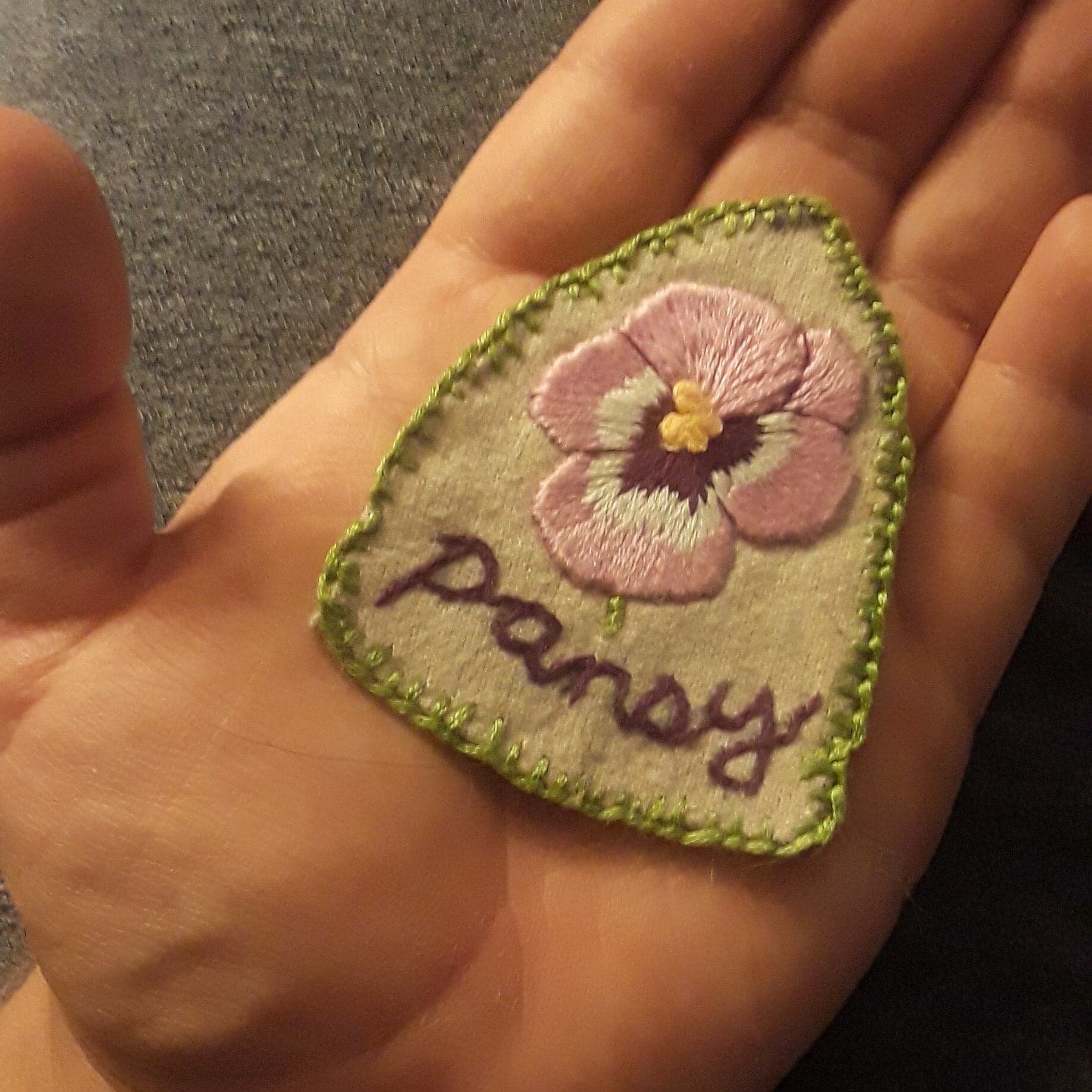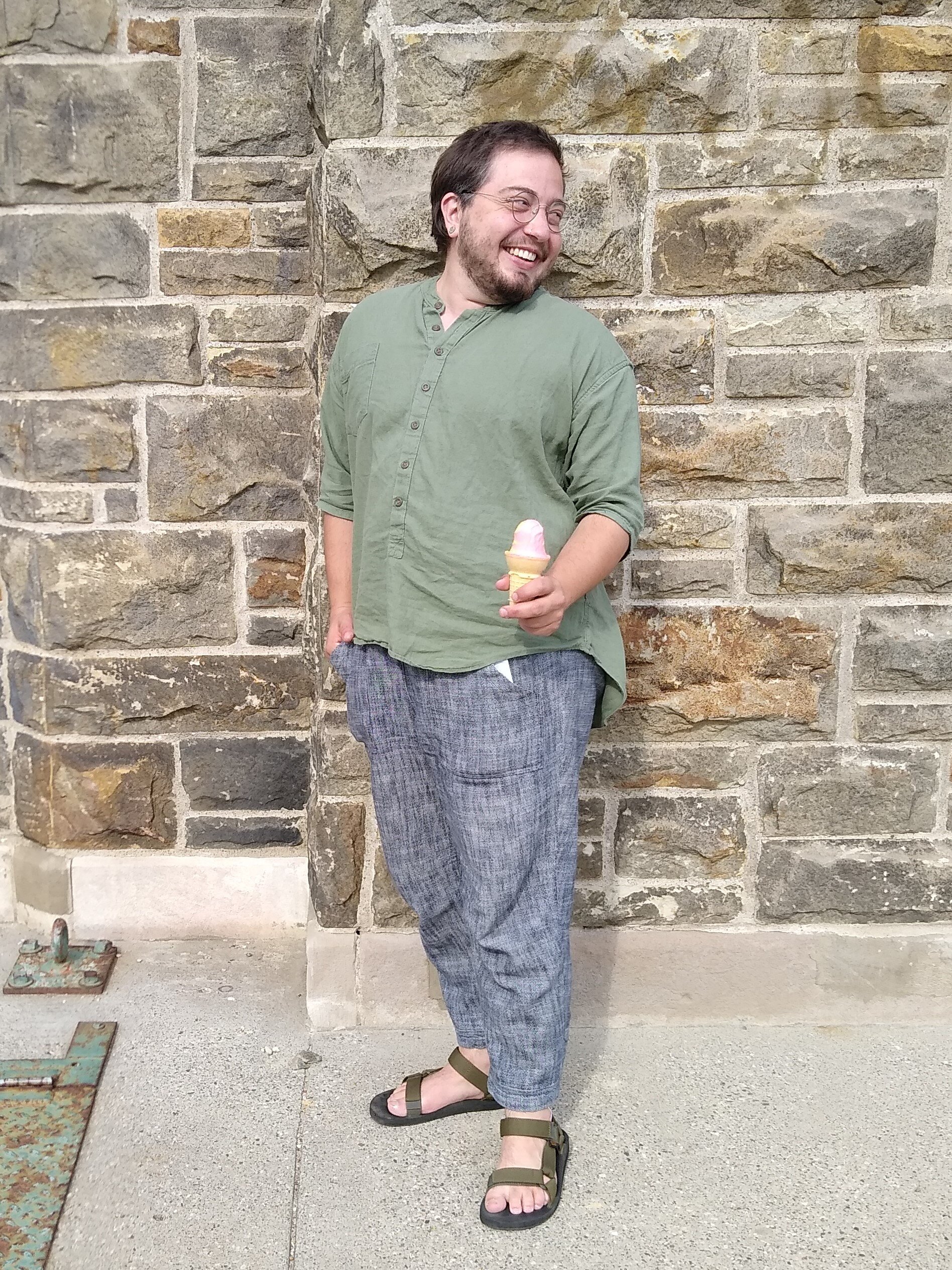Morgan D: Making and Growing
Headshot of Morgan: a white bearded person smiles at the camera.
I’ve been making clothing for all my adult life. I learned to knit as a teenager, and until a repetitive stress injury slowed me down a few years ago, I’ve been making garments for myself and my loved ones ever since. Apart from the emergency hat and mittens I make every fall when I can’t find last year’s, I primarily knit for the pleasure of it. I love fiber arts. I love learning how different fibers work, and I love tracing them back to their source. I moved from knitting to spinning, from buying fleece from local farms to growing and foraging my own spinning fibers. And through all of that I’ve largely avoided thinking about the finished garments I make for myself, and the body they are designed to cover.
I only came out to myself as trans within the last five years or so, but my relationship with my body – and clothing my body – has always been complicated. Where many of my loved ones have enormous, expansive genders that invite spectacle and play, my gender is a very small and unassuming thing. I’d rather not have a body, to be perfectly honest, and though I have to put things on it, I’d be very happy to wear identical sacks every day of the week. It’s only after a few years of medical transition that I’ve found enough peace in my body to start thinking seriously about how I want it to be seen.
The external force pushing me to think about the unthinkable (myself) is of course my partner Shannon. She thinks about clothing. She thinks about it and writes about it and talks about it, and it’s her voice in my head that asks what my clothing is saying, what it means. Shannon’s clothes are playful. They’re experimental and delight in performance and character-building. I love her attitude toward clothing and it isn’t one I can emulate. For myself, so much less fluid than my sweetheart, if my clothing is going to be considered at all, it needs to be correct. It needs to mean what I mean.
A selfie of Morgan, a smiling white person with a short beard standing in a field.
When I was preparing for top surgery in 2018, Shannon and I weren’t dating, but we’d been in a relationship previously and still nurtured a long-standing, long-distance intimate friendship. For my birthday, shortly before my surgery date, she sent me a handmade card promising that she would make me a shirt to fit my new measurements. It was the most intimate offer I could have imagined. Six months later, after notes on a muslin sent through the post office, and after a very terrified declaration of love, we met again in person. The shirt, a Seamwork Negroni, fit across my broad hips and narrow shoulders. It looked like it was meant for my body.
My body continued to change, as I’m sure it will for the rest of my life. I began to love it more: the furred roundness of my belly, the heaviness of my legs, my thickening arms. I began, too, to love who I was becoming in a way that had nothing to do with gender. In a life that had opened wide with truer possibilities, I found myself understanding how I might want to fashion myself.
Talking to Shannon about the clothes she made and patterned for me, I considered the textures and shapes and movement that made me feel right. I thought of my childhood obsession with monks; of my current pursuits as a farmer; of the practical simplicity that I always seek out when buying clothes. I thought about the fibers I love, which I’ve spent so much time studying. And I looked at myself. I let Shannon make me clothes, experiment with hunches and details, and listened hard to my own responses in front of the mirror.
A white person’s hand holding a hand-embroidered patch: a purple pansy with the word “pansy” in purple cursive below it.
I started sewing this year because I was bored: the same reason I took up inkle weaving and tapping my backyard maple for syrup. I pick up a lot of hobbies, even in a normal year, and I like to drop them once I’ve risen to the level of confident amateur. I don’t anticipate becoming a talented sewist, because, as suits me best, I’ve found a couple of patterns I love wearing, and I’m just going to keep making them over and over.
In this pandemic year when I’ve abandoned hard pants forever, I started making endless pairs of the All Well Studio Pants in textured cottons and linens, as they are the boring, comfortable leg-coverings that I’ve always wished for. And even though it required more advanced techniques than I’d planned to learn, I’ve fallen in love with the Elbe Textiles Cornell Shirt. Readers familiar with Shannon’s wardrobe will note that it’s also a favorite of hers, which is a testament to its versatility. On her it’s a quietly refined canvas for showcasing gorgeous prints and complicated finishes. On me it is the sack of my dreams (you’ll note I am short, which enhances the shirt’s sackiness), rolled or chopped to my elbows because I can’t stand full-length sleeves when I’m working with my hands. It is billowy enough in the torso that it doesn’t stick to my skin when I’m sweating, and the band collar keeps me presentable when I have to run from the farm to a Zoom meeting. In a homespun-textured linen, it has a vaguely monkish vibe, one that makes me feel like I’m living my childhood dreams (with additional beard).
Full-body photo of Morgan, a white person with short brown hair and beard, smiling and looking away while holding an ice cream cone. They are wearing a loose sage green popover button front shirt with a band collar, loose tapered pants in a navy and white woven fabric, and sandals.
Even in this limited practice, sewing is teaching me to see my body as it is, not as I imagine it or want it to be. Without judgment, I can know that I need to make a forward shoulder adjustment, or grade out for my hips. Knowing my body like this, I can imagine it – myself – into the future as I never have before.
Morgan Doherty (they/them) is a farmer, librarian, craftsperson and parent. They spend most of their time working with young queer and trans people, working with their hands in the dirt, or both. You can find them on Instagram @libraritarian. They live in Lansing, MI.
To learn more about Morgan, you can watch their IG Live conversation with SewQueer Founder, Shannon, on YouTube by clicking here.
Sew Queer is a community, and we welcome comments and discussion. In order to create a welcoming and multivocal space working towards a more just and equitable future, we review every comment before approval. Comments promoting racism, classism, fatphobia, ableism, or right wing political ideology are not allowed and will not be approved. For more details on commenting, visit our commenting guidelines.



